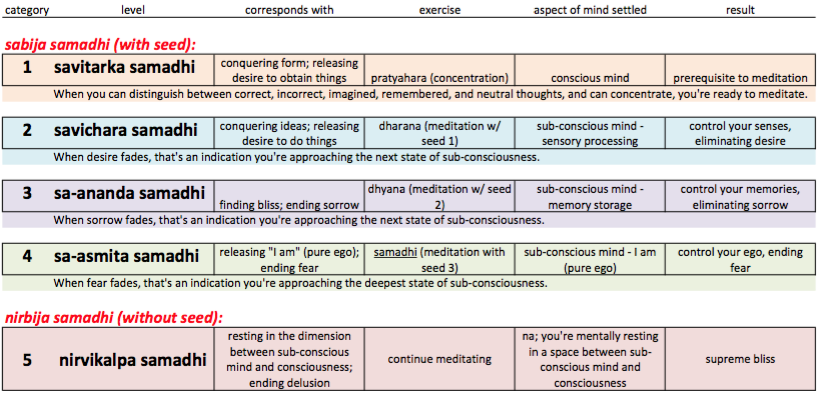I teach a prehistoric 200-line Sanskrit poem: Patanjali’s Yoga Sutras, the science of meditation.
Samadhi (pronounced “sa –ma – de”; the A’s are soft; the E is long, and the emphasis is on the middle syllable) refers to the state of being absorbed in meditation. Technically, “Samadhi” refers to both the entire practice of, AND a specific state of meditation! Not helpful! No wonder people have questions!
Sanskrit was originally verbal and phonetic [a written alphabet didn’t exist at the time] and the words often evoke their meaning.
Technically, with respect to Samadhi, there are:
- 2 categories: with and without seed; the latter refers to meditating in a state beyond our sub-conscious mind;
- 5 levels: each progressively subtler than the last; while the physical act of sitting never changes, internally, there are changes that alert us that we’re approaching or have reached a new and deeper level of mind (see the chart);
- 2 exercises: concentration and meditation; when we concentrate, we control the content of our conscious mind; when we meditate, we hold our conscious mind in neutral, observing our sub-conscious mind’s images and sensations;
- 4 aspects of mind: 1 conscious, and 3 sub-conscious (the latter corresponding with the sub-conscious mind’s three functions); and
- 4 results: meditating progressively suppresses desire, sorrow, fear and delusion – and we can do this on our own!! No magic pill; just hard work.
I liken meditating to spelunking. When we meditate we descend and explore deeper into our own sub-conscious mind until we find our true self: our consciousness.
[Note: these exercises are entirely mental (physically preparing to meditate is a subject unto itself!); concentration may be practiced anytime; meditation is a seated discipline – and thankfully, once we experience a certain level of sub-conscious mind, it’s much easier to get back!]
Namaste, Allan





Thank you Skip, very helpful!
Peace Profound,
Tim